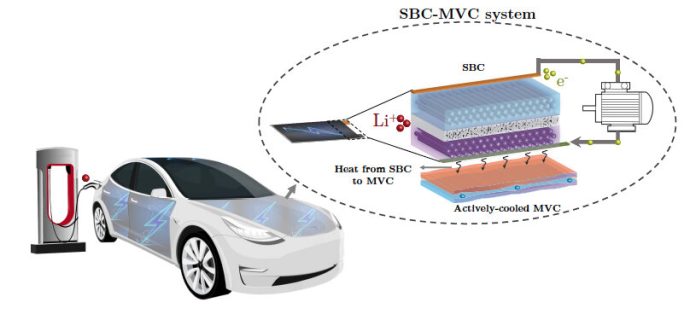Packing enough energy into a battery to power a car is putting a lot of pressure on the storage devices that, for the last century or so, have mainly been tasked with running small appliances and electronics. The stress is getting to them—manifested in malfunctions, diminished performance, and even meltdowns. Researchers at Drexel University are trying to help by taking some of the literal heat off batteries and plotting a more sustainable route for their use in electric vehicles.
Drexel Ahmad Najafi, Ph.D., an assistant professor in the College of Engineering, revealed a design optimization system for incorporating a blood vessel-like cooling network into the packaging of a new generation of carbon-fiber-based batteries used in electric vehicles. Their method balances performance-enhancing factors, like battery capacity and conductivity, against problematic variables including weight and thermal activity, that can sap performance and cause malfunctions, to provide the best battery-package specifications for any electric vehicle design.
“One of the primary hindering factors in the development of EVs, and consequently expanding their market share, is that the specific energy of batteries is low, which makes EVs heavy, especially for a long-range design,” the authors wrote.
Multifaceted batteries
Even as the demand for electric vehicles has been spurred by increasingly imminent air quality and climate change concerns and rising gas prices, the market has been tempered by a number of high-profile electric vehicle recalls over the last year that has called the durability and safety of their batteries into question.
As a result, more companies are looking at using solid batteries—a thin, carbon fiber-based version of the larger lithium-ion batteries widely used in electric vehicles—because they can be cleverly incorporated into the physical structure of the vehicle chassis as a way to cut weight.
Trimming the weight of a car by just 10% can boost its mileage efficiency between charges by as much as 6-8% according to some estimates, so replacing portions of the car frame with a carbon-fiber composite that functions both as a structural component and as a battery, could reduce the overall weight of the vehicle as well as improving its energy storage capacity.
Heating up
In order for these structural, or “mass-less,” batteries to succeed, designers must confront a challenge that arises from their use of a solid polymer—rather than a liquid electrolyte solution—as its medium for electron transit.
“Heat generation will be substantially higher in structural batteries in comparison with standard lithium-ion batteries,” Najafi explained, because the conductivity of the polymer electrolyte is much smaller than that of the liquid electrolytes used in lithium-ion batteries. This means that electrons face more of a bottleneck as they move through the polymer; they’re forced to move slower and, as a result, generate more heat as the battery discharges its energy.
“While structural battery composites are a promising technology for reducing weight in electrical vehicles, their design could certainly benefit from the addition of a thermal-management system,” Najafi said. “Not only could this improve the range of the EV, but it would also greatly reduce the chances of a thermal runaway reaction.”
Staying cool
Najafi’s research group has been developing special composite materials for heat management for a number of years. Their work draws on nature’s own cooling method—the vascular system—to dissipate heat. Modifying a design tool they invented to plot the optimal “microvascular” network, the researchers were able to design cooling composites that would work as part of the structural battery packaging currently being tested by companies like Tesla, Volvo, and Volkswagen.
The design system, presented by Najafi’s team in their latest research, can calculate the best pattern, size, and the number of microvascular channels to quickly dissipate heat from the batteries, as well as optimize the design for flow efficiency of the coolant moving through the channels.
“These composites function something like a radiator in an internal combustion engine vehicle,” Najafi said. “The coolant draws in the heat and pulls it away from the battery composite as it moves through the network of microchannels.”
Sandwiching the structural batteries between layers of cooling microvascular composites can stabilize their temperature during use and extend the time and power range in which they can function.
The right fit
As reported in the paper, the team’s structural battery optimization process considers several design parameters, such as thickness and fiber directions in each layer of carbon fiber, the volume fraction of fibers in the active materials, and the number of microvascular composite panels required for thermal regulation.
To test each combination, the group measured the stiffness of each structural battery-cooling composite laminate, to ensure they met vehicle structural integrity standards. Then they simulated the energy demand of a vehicle at various speeds over a duration of several minutes while recording the temperature of the battery, and the predicted range of the vehicle.
According to the research, computer models of one optimized system showed that it could improve the driving range of a Tesla Model S by as much as 23%. But the team notes that the real value of their work is its ability to glean the best combination of battery size and weight—including enough cooling capacity to keep it functioning—for any electric vehicle in production now and in any future designs.
“While we know that every bit of weight saving can help improve the performance of an EV, thermal management can be just as important—perhaps more, when it comes to making people feel comfortable driving them,” Najafi said. “Our system strives to integrate improvements in both of these areas, which could play an important role in the progress of electric vehicles.”









